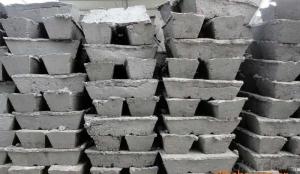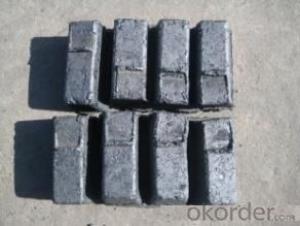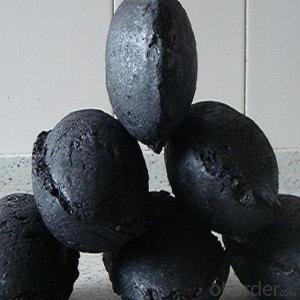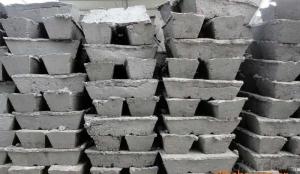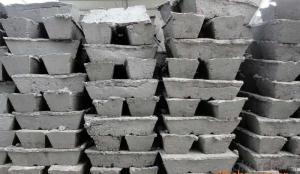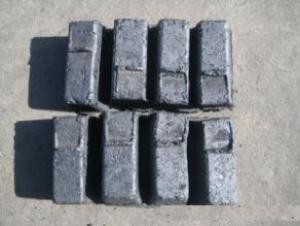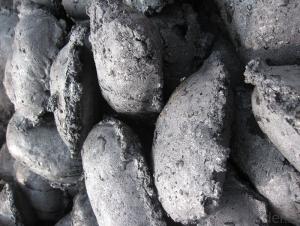Carbon Electrode Paste with low Ash 4-7%
- Loading Port:
- Tianjin
- Payment Terms:
- TT OR LC
- Min Order Qty:
- 20 m.t.
- Supply Capability:
- 3000 m.t./month
OKorder Service Pledge
OKorder Financial Service
You Might Also Like
Spcifications
1:carbon eletrode paste
2:for ferroalloy,calcium carbide manufacture
3:HS 3801300000,YB/T5212-1996,ISO9001:2008
Product Description
Carbon Electrode Paste is a self-baking electrode used in submerged arc furnaces for delivering power to the charge mix. Electrode Paste is added to the top of the electrode column in either cylindrical or briquette form. As the paste moves down the electrode column the temperature increase causes the paste to melt and subsequently bake forming a block of electrically conductive carbon. Electrode Paste is essentially a mix of Electrically Calcined Anthracite (ECA) or Calcined Petroleum Coke (CPC) with Coal Tar Pitch.
Graphite/Carbon Electrode Paste Specification:
PARAMETER UNIT GUARANTEE VALUE
Ash.( % ) 4.0 max5.0 max 6.0 max 7.0 max 9.0 max11.0 max
V.M (%) 12.0-15.512.0-15.5 12.0-15.5 9.5-13.5 11.5-15.511.5-15.5
Compress Strength. 18.0 min17 min 15.7 min 19.6 min 19.6 min19.6 min
Specific Resistance 65 max68 max 75 max 80 max 90 max90 max
Bulk Density 1.38 min1.38 min1.38 min 1.38 min 1.38 min1.38 min
Picture:
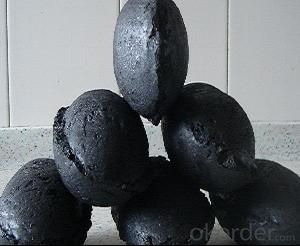
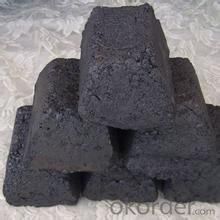
- Q: What are the impacts of carbon emissions on the stability of rainforests?
- The stability of rainforests is significantly affected by carbon emissions, resulting in negative consequences for both local ecosystems and the global climate. One notable impact is the direct contribution to climate change, as carbon dioxide (CO2) is a major greenhouse gas responsible for trapping heat in the atmosphere. This leads to an enhanced greenhouse effect, causing global temperatures to rise and negatively impact rainforests. As temperatures increase, rainforests face various challenges. Firstly, higher temperatures can result in more frequent and intense droughts, making it difficult for rainforests to maintain moisture levels. This leads to reduced water availability for plants and animals, causing stress, hindered growth, and increased susceptibility to diseases and pests. Additionally, droughts can raise the risk of wildfires, devastating large areas of rainforest and further disrupting the delicate ecosystem. Another significant consequence of carbon emissions is the alteration of rainfall patterns. Climate change disrupts regular rainfall cycles in rainforest regions, leading to either more intense rainfall events or prolonged dry periods. These changes disturb the natural balance within rainforests, affecting the growth and reproduction cycles of plants and animals. For example, certain tree species may struggle to reproduce or regenerate if their seeds require specific conditions that are no longer met due to altered rainfall patterns. Furthermore, carbon emissions contribute to increased concentrations of CO2 in the atmosphere, directly impacting plant physiological processes. While some studies suggest that higher CO2 levels can initially enhance plant growth through increased photosynthesis, the long-term effects are more complex. Elevated CO2 can disrupt the nutrient balance within rainforest ecosystems and may favor certain plant species over others, resulting in shifts in species composition and potentially reducing overall biodiversity. Lastly, the impacts of carbon emissions on rainforests extend beyond the local ecosystem. Rainforests act as crucial carbon sinks, absorbing a significant amount of the world's CO2 emissions. However, as rainforests face increased stress from climate change, their ability to absorb and store carbon may decrease. This creates a dangerous cycle, as reduced carbon storage in rainforests leads to even higher atmospheric CO2 levels, further worsening climate change. In conclusion, carbon emissions have profound effects on the stability of rainforests. From contributing to climate change and altering rainfall patterns to affecting plant physiology and reducing carbon storage capacity, the consequences are extensive and harmful. Protecting rainforests and reducing carbon emissions are crucial steps in preserving the stability and biodiversity of these vital ecosystems.
- Q: How does carbon affect the formation of smog?
- Carbon plays a significant role in the formation of smog, particularly in the form of carbon monoxide (CO) and volatile organic compounds (VOCs). When fossil fuels are burned, such as in vehicles, power plants, or industrial processes, carbon is released into the atmosphere in the form of CO and VOCs. These carbon emissions, especially in areas with high population density, can contribute to the formation of smog. Smog is a mixture of air pollutants, primarily ground-level ozone, which is formed when nitrogen oxides (NOx) and VOCs react in the presence of sunlight. Carbon monoxide is a precursor to the formation of ground-level ozone. It reacts with nitrogen oxides and sunlight to form ozone, a major component of smog. VOCs, on the other hand, react with nitrogen oxides in the presence of sunlight to form additional ground-level ozone. Additionally, carbon particles, also known as black carbon or soot, can contribute to the formation of smog. These particles absorb sunlight and heat the surrounding air, leading to temperature inversions. Temperature inversions trap pollutants close to the ground, preventing them from dispersing and exacerbating smog formation. Reducing carbon emissions is crucial in controlling and preventing smog formation. Implementing cleaner technologies, such as catalytic converters in vehicles and using cleaner fuels, can help decrease the release of carbon monoxide and VOCs. Furthermore, promoting renewable energy sources and reducing reliance on fossil fuels can significantly reduce carbon emissions, thus mitigating the formation of smog.
- Q: What are some common compounds of carbon?
- Due to its unique bonding abilities with other carbon atoms and a variety of elements, carbon has the ability to form a wide range of compounds. Carbon dioxide (CO2), methane (CH4), ethanol (C2H5OH), ethene (C2H4), acetic acid (CH3COOH), and glucose (C6H12O6) are some common compounds of carbon. These compounds play crucial roles in various fields such as biology, chemistry, and industry. For instance, carbon dioxide serves as a greenhouse gas, impacting the Earth's climate system significantly. Methane, on the other hand, is a potent greenhouse gas released during natural gas production, contributing to climate change. Ethanol is a widely-used alcohol as a fuel and solvent, while ethene is utilized in plastic production. Acetic acid is a vital component in vinegar, and glucose acts as a primary energy source for living organisms. The vast versatility and importance of carbon are evident through these compounds.
- Q: How is carbon used in the production of graphite?
- Carbon is used in the production of graphite by undergoing a process known as graphitization, where carbon atoms are arranged in a hexagonal lattice structure. This process involves heating carbon at high temperatures, causing the carbon atoms to align and form layers, resulting in the formation of graphite.
- Q: Advantages of carbon fiber
- The specific strength and specific modulus of the composite formed with resin are about 3 times higher than that of steel and aluminum alloy. Carbon fiber composites can be used in space, missile and sports equipment to reduce weight, improve payload and improve performance. They are important structural materials in aerospace industry.
- Q: How is carbon used in the production of textiles?
- Textile production utilizes carbon in multiple ways, encompassing the utilization of carbon fibers, activated carbon, carbon black, and carbon nanotubes. Carbon fibers, for instance, serve as a lightweight and sturdy reinforcement for fabrics, enhancing their durability and performance. Activated carbon, known for its porous nature, finds extensive use in the textile industry due to its ability to adsorb and eliminate undesirable odors and chemicals. Consequently, it is employed in the manufacturing of sportswear, workwear, and specialized textiles where odor control is crucial. Additionally, carbon black, a finely powdered substance composed of carbon particles, functions as a pigment in textile printing and dyeing. By imparting a deep black hue, it is widely employed in the production of garments, upholstery, and other textiles requiring a dark coloration. Moreover, the development of carbon nanotextiles represents an innovative application of carbon in the textile realm. These textiles, fabricated from carbon nanotubes, exhibit exceptional properties such as high electrical conductivity and thermal stability. Consequently, they are ideal for applications involving wearable electronics, smart textiles, and conductive fabrics. In conclusion, carbon's incorporation into textiles through the integration of carbon fibers, activated carbon, carbon black, and carbon nanotubes contributes significantly to the strength, durability, odor control, coloration, and functionality of various textile types.
- Q: What is the relationship between carbon emissions and deforestation?
- The relationship between carbon emissions and deforestation is that deforestation contributes significantly to carbon emissions. When trees are cut down or burned, the stored carbon within them is released into the atmosphere as carbon dioxide (CO2), a major greenhouse gas. This process directly contributes to climate change and global warming. Additionally, deforestation reduces the Earth's capacity to absorb CO2 through photosynthesis, further exacerbating the carbon emissions problem. Therefore, reducing deforestation is crucial in mitigating carbon emissions and combating climate change.
- Q: How does carbon dioxide affect the growth of marine organisms?
- Carbon dioxide affects the growth of marine organisms by increasing water acidity, which can hinder their ability to build shells and skeletons, disrupt their reproductive cycles, and ultimately lead to reduced growth and survival rates.
- Q: Who can explain that bare feet on fire carbon don't burn feet?
- The fire is red carbon, but no signs of fire and water after scald. Actually, that's a very simple physical phenomenon. The most mysterious matter where we can buy, can make the carbon fire red instantly cool, people ran fast, naturally not hurt hair.These two substances, one is white borax, and the other is red cinnabar (also known as cinnabar). It turns out that the crystals are dissolved because they absorb large amounts of heat. When borax or cinnabar scattered on the surface of carbon fire, because the heat will make the wood surface temperature drop.
- Q: What is sintered carbon?
- Sintered carbon is generally used as a filter element, and also of good quality, but very few, most of which are of poor quality.Sintering is the process in which powder or powder compacts are heated to a temperature below the melting point of the basic component and then cooled to room temperature at a certain rate and speed. The result of sintering is bonding between the powder particles, increasing the strength of the sintered body, and changing the aggregate of the powder particles into agglomerates of grain to obtain the desired physical or mechanical properties of the product or material.The sintering process refers to the processing program and the sintering process system selected according to the characteristics of the feedstock. It has a direct and important influence on the production and quality of sinter production.
Send your message to us
Carbon Electrode Paste with low Ash 4-7%
- Loading Port:
- Tianjin
- Payment Terms:
- TT OR LC
- Min Order Qty:
- 20 m.t.
- Supply Capability:
- 3000 m.t./month
OKorder Service Pledge
OKorder Financial Service
Similar products
Hot products
Hot Searches
